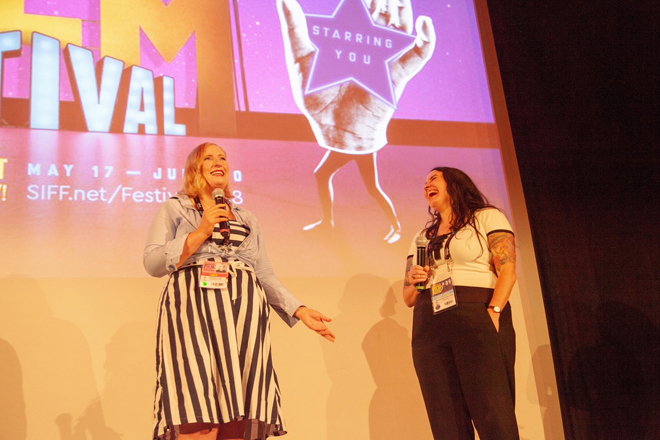
Recently, Miss Clarke, sat down to talk about filmmaking, all things The Devil’s Doorway, creepy real life tales to tingle your spine, and the Irish Catholic Church. If that all sounds a little wacky and diverse, well it is, so enjoy!
CrypticRock.com – What inspired you to get involved with film and, more specifically, directing films?
Aislinn Clarke – Oh wow! I’ve been a lifelong film fan, particularly Horror films. My dad was a big film fan as well, and he was really into Horror films. It was just kind of a big feature of my childhood: I grew up in the ‘80s, and we would go to the video store Friday nights and get out a scary film. He would edit out – as in, he would make me leave the room – if something happened that he felt was not suitable. (Laughs) I mean, that was generally if there was anything kind of sexy. In terms of Horror stuff, I saw The Exorcist (1973) when I was seven. (Laughs) I’m sure he edited out that scene with the crucifix, if you know what I’m talking about. That completely horrified me, but in a way that I loved.
I saw A Nightmare on Elm Street (1984) around that same age, and I have been totally obsessed ever since. I have a voracious appetite for film, not just Horror films. I studied film and went on to do an M.A. in Film and Visual Arts, and then an M.A. in Screenwriting. I’m a big film fan: I worked in cinemas for years. The reason I took that job is because I got to see all the movies for free when I was a film student. I’m just a big fan of films and, in particular, Horror films. I imagine that, most times, some fans think about whether or not they would like to make their own.
I had worked in television for years, in factual entertainment. I felt like that wasn’t quite the right home for me, and I just kept gravitating back towards it. Generally, I’m kind of an introverted person. I think it’s harder to start making films when you’re like that because it’s such a collective endeavor, and big personalities tend to get pushed forward. So, I was quietly making films by myself with my 8mm camera; and I would make films just by myself.

It was always something I gravitated towards, was telling stories with visual images. I worked in theater then for a number of years – where I learned a lot about working with actors, in particular – and that was really where I started to cut my own teeth in that respect. Eventually, I came back to what I knew: I knew I wanted to make movies when I was seven! But I didn’t know what it meant; I didn’t know what a director was. I remember very clearly thinking that this was kind of something that I always gravitated towards, I just had to figure out how to get there, you know?
CrypticRock.com – Was it ever hard for you, being somewhat introverted, to start working with actors?
Aislinn Clarke – Well, actually, not really. I’m very comfortable working with actors, and it’s one of my favorite parts of the process. I think because in theater, in particular, working with actors is, the process of it is different to how a lot of people work with actors in films. Everybody is directing differently, but my approach: I like to have a lot of rehearsal and a lot of one-on-one time with actors. It’s just natural to me. Essentially what I am doing, in theater or in films, is sitting down with the actor and we’re both getting really into the script, we’re picking it apart, “Who is this character and why is he doing this?” And those kinds of conversations are interesting to me; I don’t find them difficult. I’ve always been kind of an introvert, but if I’m interested in something I’ll talk to anybody!
I made a documentary in my mid-20s for broadcast and television, and that was kind of the beginning of having to put myself out there a bit more and be a bit braver. At this point, when I’m in my late 30s, I’m a lot more comfortable with all of that and really my focus is just on getting the work done. My job, a large part of it is in helping everybody get involved with my enthusiasm – “This is going to be good!” I’m a lot better than I would have been back in the day.
CrypticRock.com – Up until recently, you have directed short films. What was it like transitioning from shorts to a feature-length offering?
Aislinn Clarke – Well, the obvious thing would be just the scale of it. It’s just a bigger undertaking: it takes more time, there’s more people involved generally – things like that. So, that was the major difference: the intense focus that was needed for that, for the period. It was shot very quickly; sixteen days is not a long time to shoot. There are people who shoot short films for that length of time, but I’ve never done that. The major difference was just the scale of it; there were more people involved than there are in shorts – we had a bigger crew. We didn’t have any money, you never have any money; maybe some money, but it was low-budget and that’s the constant of things, you know? (Laughs)
Having a feature out is a lot different to having a short out, because features actually exist in the marketplace in a way that shorts don’t. Shorts exist to act as calling cards for directors; they’re a part of the process of you developing who you are as a director. Whereas, a feature film is a product that’s out there in the marketplace and that is consumed, is a consumable thing. That experience of having it out there – on Friday, in the States – is going to, the idea that the public can buy tickets to the movie – someone might be going on a date and they’ll choose to go and see my film. (Laughs) It’s just really strange and kind of wonderful, because you don’t really get that with shorts.
CrypticRock.com – The Devil’s Doorway is a wonderful film, and the truth is that it truly does not read like low-budget at all.
Aislinn Clarke – Well, thank you very much! But it was low-budget; it was like 230,000 pounds sterling. Which, a few years back, I would have thought was an absolute fortune to make a film with! But when you’re talking a feature film, it doesn’t go far and it is technically low-budget. So, we didn’t have the luxury of money, that’s for sure. We did what we had to! It was done very much on the cheap, but we just had really good people. I think a crucial part of why it doesn’t look so much like it was done on the cheap, just the sets and design, John Leslie, who was the Location Manager, is just a fantastically knowledgeable and talented person, who just knows every corner of the country and was so good with coming up with the locations. He has millions of things – he has a great big barn that has all kinds of things – even down to period matchbooks, 1960. Everything was detailed correct, and he was active in keeping on top of that; so I think that was a big part of it.
Then, I’ve made a lot of period stuff. For some reason, I just tend to gravitate toward period work. So, I also have a pretty good eye for – a lot of people when they make period stuff, they mash up a lot of different decades and they don’t realize that they’re doing it. I have a very keen eye for, “This is actually 1960; it’s not 1965 and it’s not 1968.” It’s 1960 and there’s a great difference in a couple years! So, I think all of that stuff helps to make it feel like it’s got higher production values than what we actually could afford. (Laughs)

CrypticRock.com – Okay, so to delve more deeply into The Devil’s Doorway, you directed as well as had a hand in writing the script. What was your inspiration for the story?
Aislinn Clarke – Well, in the first instance, the producers – who are also two of the other writers – came to me with, they had a one-page idea for a very different film. They were shopping around – looking for different directors, and I wasn’t the only person they spoke to – but they were looking to make a Found Footage film in an abandoned Magdalene Laundry, shot on Go-Pros.
I thought it was a really good idea to set a Horror film in a Magdalene Laundry, but it should be at the height of these places when they were fully-functioning in the society; you should do it in 1960, it seemed natural to me. Because I’d shot in film in the past, I said, “Why wouldn’t you set it in 1960 and shoot it on 16mm, instead of making it now?” Where the human drama is something from the past, set it in the past where it’s at the height of all of that, and shoot it in 16mm because nobody’s really, as far as I am aware, made a period Found Footage film. The subgenre is so well-trodden that I thought it needed, if it was going to find its space in the subgenre, it should really be fresh.
Everything became completely different then. They went with that: they liked the sound of that and they took me on for it; that’s kind of the genesis of it. Then, I had done a lot of research into Magdalene Laundries over ten years ago, for a documentary which I ended up never making. But I’ve done a lot of research and spoken to a lot of women who have been in these institutions, and to children of women who have been in these institutions and never knew their mothers. So, I had done a lot of that ground research and visited old Magdalene homes, and things like that; I had a lot of that in my back pocket.
In terms of the story, it just so happened that at the same time all of this was happening, my father was dying. He had, what you call in the States, ALS – we call it Motor Neuron Disease. He got his diagnosis around the same time that I first met the producers, and he was dead six months later, which was just before we went into pre-production. Basically, when I was writing the script, I very much based the character of Lalor, the older priest, is very much based on and has a lot of my dad in him – the things that he says. Because at that time I was dealing with all of the stuff going on, and a lot of the things that he expresses – because my dad struggled with faith his whole life – come almost directly out of my dad’s mouth. That character, to me, reflects a lot of the person that my father wa. The film is actually dedicated to him. He was a massive Horror fan, as well; it’s such a shame he didn’t get to see it. I think he would have been proud!
CrypticRock.com – Absolutely! Now, there’s a definite vibe of 1973’s The Exorcist meets 1968’s Rosemary’s Baby throughout The Devil’s Doorway. Those are two truly iconic Horror offerings. Was there ever a concern of stepping into territory that was too classic and therefore a bit dangerous?
Aislinn Clarke – I never really thought about that. I think if you have integrity when you’re making something, it doesn’t really matter what people make of it at the end of the day. If you are doing it and coming from a place of integrity, you’ve done the best that you can do. Once it’s out there, there probably will be people that don’t like it, that take offense to it – particularly in Ireland, given the subject matter. It’s a very controversial thing and there may be people that won’t stand for it, but that’s not really something that I really concerned myself with because it has nothing to do with me or the process of me making this thing. My intentions were completely genuine.
I love The Exorcist and I love Rosemary’s Baby, I absolutely adore Rosemary’s Baby; they are among my top favorite films ever. If you have an investigation going on in a convent – really for me, the primary thing was talking about power structures in the Irish Catholic Church. If you’re having an investigation, you’re going to have two priests, and if you have two priests you’re going to have people talking about The Exorcist. So, for me, I wasn’t thinking, “Oh, I am referencing The Exorcist.” I was thinking how can I tell this story about the Irish Catholic Church’s power structures and the corruption? That’s where I was coming from. The fact that it’s two priests is kind of incidental.
Then, of course, there’s what I call a hint of possession. There’s Kathleen’s character: she’s not a traditional possessed character in that respect for a number of reasons. First of all, because I think that has been done an awful lot, and I’m not sure that I’ve got anything new to add to that. I think very often the possession subgenre is problematic about what it says about female sexuality and things like that. Given that we are in a Magdalene Laundry and she is a Magdalene girl – and they were condemned to these places because of perceived natural flaw in their sexuality, in their female-ness – I think it could be really problematic to make her just an evil possessed girl. Which is what I was originally presented with: that’s what the producers and the other writers wanted to do.
But, for me, she’s more complicated than that; she’s more ambiguous. She’s certainly possessed by dark forces, but whether that’s an internal thing or an external thing is up for the viewer to decide. I have my own sense of what that is, and I don’t really believe in authorial intent; what I think doesn’t matter. You finish the film when you watch it; each person who watches it, they all have their own impression of what it is. For me, she’s more like a Virgin Mary character; she’s magically pregnant yet she’s a virgin. The conflict there, she’s in this uber Catholic organization where the Virgin Mary is upheld to such a high standard; there’s statues everywhere. Yet, this is a girl who is pregnant, the same as the Virgin Mary, and who is being treated like a beast. She is beset by dark forces but, to me, they are external; it’s because she is pure, rather than impure, that they are attracted to her.
Other people can read it in different ways and that’s valid also, but, for me, I wasn’t trying to do The Exorcist again, ‘cause that’s just not where I was coming from. In terms of Rosemary’s Baby, I absolutely adore that film; it’s a magnificent piece of work. I guess there are some similarities there also, but in a very different way. Again, people will read it in very different ways, but I don’t see the child as necessarily being evil; it could be the complete opposite of that. It’s all up to interpretation!
It’s not a bad thing to be compared to those two movies, because those are excellent movies! There will be uber Horror fans who think, “Oh, you’re trying to do The Exorcist,” or whatever. I wasn’t but at the end of the day, people will think what want and I can’t control that!

CrypticRock.com – There will always be naysayers but it’s a wonderful film. You shot and edited the film in such a way as to make it feel nostalgic and vintage, like an oldie that has only just been rediscovered. We already touched on this briefly, but what inspired this and how did you go about bring the 1960s back to life?
Aislinn Clarke – I think the crucial thing was – and again, I had shot in film before, in 35mm film and then in 8mm film. From the very get-go, it just seemed like the obvious thing to do: if we’re making a Found Footage film, you want it to feel as authentic as possible. That is one of the major elements of Found Footage no matter when it’s set, is that it should feel like someone really shot this and you’re seeing that document. For me, because I have experience with film, I don’t really believe that you can just slap a filter on it in post-production and it will really stand in; I think there’s a glaring difference between things that are shot on real film, particularly skin tones and that kind of thing.
The major decision was we have to use film where we really wanted to, and we had to convince the producers that that was worthwhile. I committed to and I like to do this, I rehearsed with the actors a lot in advance so that when we’re shooting we’re not shooting many feet of film searching for a moment; we already have done a lot of that groundwork before we hit the set. A concession that we made with our producers, because there is always worry about the concern that, well, what if some of it gets corrupted or there is an issue – that kind of thing. So, we agreed that, in the scenes where there was going to be VFX done in post, we would shoot digitally, and then spend time in the grave matching up to the rest of the footage. We did do that: parts of it are shot digitally and we just spent time matching it up with the other footage.
I think that was a major part of it, but then, of course, costumes – that was Susan Scott on Costume Design and John Leslie with his brilliant locations – planning those locations and also being able to dress them in such a way that it was so complete. He was very detailed in that! Like I said to you, even down to the matchbox – which you probably didn’t even see. On Father Thomas’ desk when he’s smoking a cigarette, every single thing was period appropriate.
CrypticRock.com – That attention to detail definitely pays off in the finished product, for sure. As far as the Horror elements of the story, there is always a fine-line to walk between being scary or being creepy; creepy tends to resonate more, as it haunts the viewer long after the film ends. That said, you do a beautiful job with maintaining a truly creepy atmosphere throughout the film, which is rare in today’s Horror. On set, was there any one scene that was particularly creepy or scary to shoot?
Aislinn Clarke – I definitely lean towards the creepy myself, and I prefer that; I’m more kind of creepy than a fan of scary, particularly jump-scares and that kind of thing. It sometimes works; but I’m more of a fan of atmosphere and a general creepiness and that’s what we were trying to cultivate in this. I like that sense that it would linger, that’s what we tried to do!
When we were actually on the shoot, both locations were themselves kind of creepy; they were just very cold, old, strange, weird places to be. One thing particularly, there’s a part of the film where there’s a nun, a dead nun in the underground – in the room where the Satanic mass has happened. Later on, there’s a nun in there and she’s plucked out her eyeballs. (Laughs) That actress – who actually is a friend of mine in real life – she ended up having to be stuck down there; she had makeup on her eyes, so she couldn’t open them or anything. She ended up down there on her own for quite a long time while we were busy setting up outsde; she was in that room alone. I think she found that really creepy! It was pitch dark and she couldn’t open her eyes, so it was a really dank, weird place to be.
Apart from that, most any set that I’ve been on, even when there’s something that you’re shooting that’s really creepy or disturbing in the final film, it’s incorporated into the day’s work. The atmosphere is totally different when you’re shooting. One thing that happened in real life that was creepy was that the day after we left – and we were supposed to still be there the next, but we weren’t – the entire roof caved in! The room that we were using as the church just caved in the day after we left. If you were superstitious, you could think that was some kind of sign.

CrypticRock.com – That is truly creepy! The film has a lot of different layers and, very generally speaking, often times anything religious is lost on American audiences – though that is perhaps not the case in Ireland. That said, what do you hope audiences will walk away with?
Aislinn Clarke – I would like people to come away with an understanding of kind of what it’s about, which is about power structures; and that’s a universal thing, it’s not just specific to Irish Catholicism or any other religion. Power corrupts – that’s the message that’s at the heart of it. I can’t control what people will take away from it; people will take all kinds of things away from it. But that’s the potential message that I was trying to communicate.
So often in the Irish Catholic Church there were so many atrocities that happened. A lot of fingers have been pointed at individual wrongdoers, but that’s not helpful because it’s not the individual wrongdoers; it’s the whole institution that cultivates an ultimate evil. No one individual can make it better either; not one hero can walk in and fix everything. The whole power structure is a mess, so that’s kind of what the heart of the film is.
CrypticRock.com – There is definitely a lot of material that will resonate heavier with audience members who have a Catholic background of any kind. That said, do you expect to get any kind of reaction or response from the Catholic Church?
Aislinn Clarke – I don’t know. The thing is that I’m not actually pointing the finger at the Church alone; it’s the church structure collusion that I’m accusing of being at fault here. I don’t have faith myself, but I respect people that do! It’s not faith that’s the problem, it’s how power is misused. If anyone in the Church takes offense – and I think that’s quite clear as the intention of the film. Father Thomas would like to have faith, he wants to believe in God, it’s just that the structure is making it difficult for him to do so. I have great empathy for that! If anyone takes offense to it, I feel like I can defend it because my intentions are genuine and I’m not just trying to trash the Church in particular. I’m sure somebody will have a problem with it, but, again, that’s beyond my control. All I can say is that’s not what I was doing, and if you pay attention to what the film is saying you’ll see that that’s not actually what I was getting at at all.
CrypticRock.com – Is there a possibility of a sequel to The Devil’s Doorway?
Aislinn Clarke – Gosh, nobody’s asked me that yet! I haven’t really thought about it yet, but I’d always be open to anything. I love the world and the characters, and so on, but of course some of them are dead. I wouldn’t be against it if I could figure out a way to do it that made it relevant and that there’d be a point in doing it. I don’t know. I wouldn’t be against it!
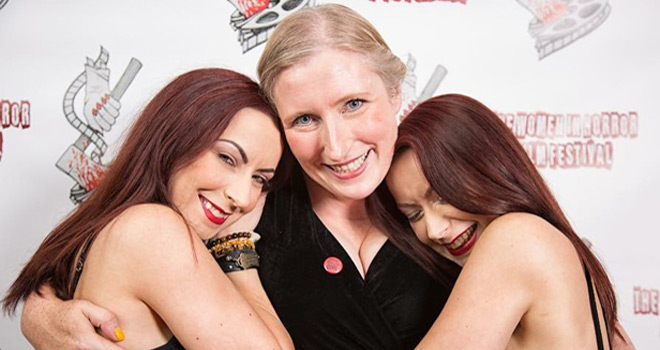
CrypticRock.com – What’s next for you?
Aislinn Clarke – I’m working on a number of projects in the film business. So, it’s just a case where what’s going to fly first, you know? I have a couple of scripts attached to different producers, and they’re all at various stages of financing. It’s just about which one gets all the pieces put together first. Generally, when I’m writing, even if it’s not Horror, there’s a dead body somewhere; I gravitate towards the dark side. I have a project which is more what you would call a Thriller, because there aren’t really any Supernatural elements; there’s a hint of Horror to it, but it’s more of a Thriller. Then I have a couple projects which are definitely Horror, so we’ll just have to see which one gets there first. I’ll be making a film next year, I’d like to think.
CrypticRock.com – It will be exciting seeing what you will dream up next! Last question. At CrypticRock, we cover music as well as films, particularly Horror and Sci-Fi films. We now know that you are definitely a fan of Horror, so are you also a fan of Sci-Fi?
Aislinn Clarke – Not actually massively. I’m very much into film and I like films that, I prefer Science Fiction that delves more into the human drama, the human condition, than the Science Fiction which are more tacky. They interest me less. But I’m definitely much more of a Horror fan than Sci-Fi.
CrypticRock.com – Okay, so what are some of your favorite Horror films?
Aislinn Clarke – Well, we’ve already mentioned a couple of them! Rosemary’s Baby, I absolutely adore: it’s possibly my favorite film of any type. I love The Exorcist. A lot of my favorite movies are from way back. Don’t Look Now (1973). I love The Omen (1976). I also like recent films like, everybody loves It Follows (2014). I liked Starry Eyes (2014). Of course, I loved Hereditary, which I saw a couple weeks ago. I think that’s the best new Horror film I have seen in a long time. I know it’s getting a lot of mixed reviews and some people don’t like it so much, but I thought it was really brilliant.

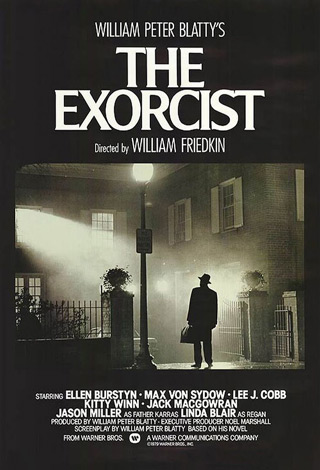
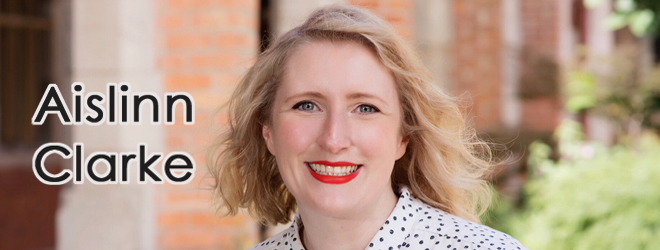

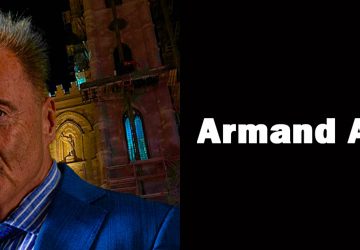


No comment